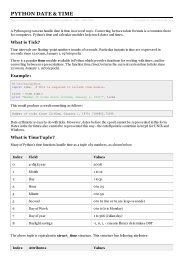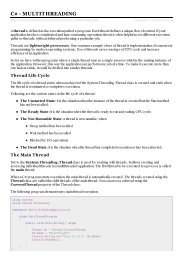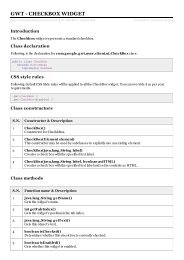download pascal tutorial (pdf - Tutorials Point
download pascal tutorial (pdf - Tutorials Point
download pascal tutorial (pdf - Tutorials Point
You also want an ePaper? Increase the reach of your titles
YUMPU automatically turns print PDFs into web optimized ePapers that Google loves.
To check for a nil pointer, you can use an if statement as follows:<br />
if(ptr nill )then (* succeeds if p is not null *)<br />
if(ptr = nill)then (* succeeds if p is null *)<br />
Pascal <strong>Point</strong>ers in Detail:<br />
<strong>Point</strong>ers have many but easy concepts and they are very important to Pascal programming.<br />
There are following few important pointer concepts, which should be clear to a Pascal<br />
programmer:<br />
Concept<br />
Pascal - <strong>Point</strong>er arithmetic<br />
Pascal - Array of pointers<br />
Pascal - <strong>Point</strong>er to pointer<br />
Passing pointers to<br />
subprograms in Pascal<br />
Return pointer from<br />
subprograms in Pascal<br />
Description<br />
There are four arithmetic operators that can be used on<br />
pointers: increment, decrement, +, -<br />
You can define arrays to hold a number of pointers.<br />
Pascal allows you to have pointer on a pointer and so on.<br />
Passing an argument by reference or by address both enable<br />
the passed argument to be changed in the calling subprogram<br />
by the called subprogram.<br />
Pascal allows a subprogram to return a pointer.<br />
<strong>Point</strong>er arithmetic<br />
As explained in main chapter, Pascal pointer is an address, which is a numerical value<br />
stored in a word. Therefore, you can perform arithmetic operations on a pointer just as you<br />
can on a numeric value. There are four arithmetic operators that can be used on pointers:<br />
increment, decrement, +, and -.<br />
To understand pointer arithmetic, let us consider that ptr is an integer pointer, which points<br />
to the address 1000. Assuming 32-bit integers, let us perform the increment operation on<br />
the pointer:<br />
Inc(ptr);<br />
Now, after the above operation, the ptr will point to the location 1004 because each time<br />
ptr is incremented, it will point to the next integer location, which is 4 bytes next to the<br />
current location. This operation will move the pointer to next memory location without<br />
impacting actual value at the memory location. If ptr points to a character, whose address<br />
is 1000, then above operation will point to the location 1001 because next character will be<br />
available at 1001.<br />
TUTORIALS POINT<br />
Simply Easy Learning Page 93
















